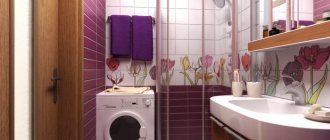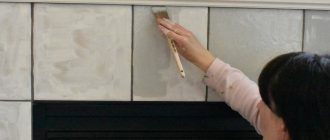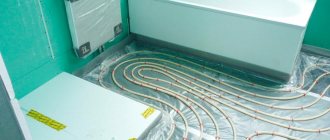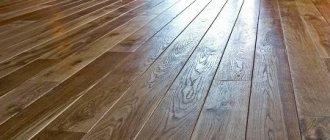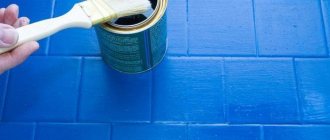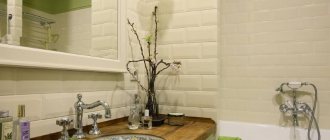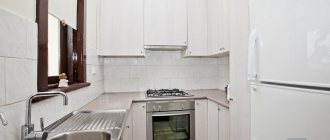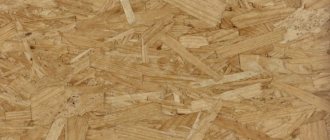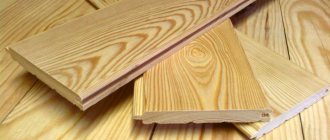The design of the living space and the standard of living of the owners are assessed by the interior of the hallway. Today, what kind of floor tiles are chosen for the kitchen and hallway and how they harmonize with the entire decor says a lot. This type of cladding has been used for a very long time, and its ancestor is considered to be plates of natural marble, which today is used as an imitation in porcelain stoneware and tiles. Hexagons, squares and rectangles are laid out in different ways, but experts will tell you about this.
Floor tiles are a finishing material designed not only to improve the performance characteristics of the floor in a room and protect it, but also to introduce original design elements to decorate it.
Pros and cons of ceramic tiles
In order not to be unfounded, claiming that ceramic tiles are actually an ideal floor covering, we list the main advantages of this material:
- high strength . This indicator, of course, depends on the class of the tile, but in general the material tolerates mechanical damage well, withstands significant loads and retains its original appearance for a long time;
- the durability of the tiles reaches 50 years, but you should count on such durability if the installation was carried out in accordance with all the rules;
- moisture resistance . The floor and walls in the bathroom are laid with tiles, so that the material will calmly carry those droplets of rainwater and melted snow that fall on the tiles in the hallway;
- fire resistance . The material, prepared on the basis of clay, quartz and other minerals, and fired in a kiln, acquires record resistance to high temperatures;
- hygiene . It is very easy to wipe off various types of dirt from tiles; you can use almost the entire range of detergents, and this is important for hallways and corridors;
- environmental friendliness . The tiles are made from natural raw materials, so the material can be considered completely safe for health;
- huge selection and aesthetics . Manufacturers offer tiles in different sizes, shapes, colors and textures. A huge assortment of floor tiles for the corridor can be found on the website of the KERAMOGRANIT.RU store, which offers products from the world's leading brands. There is an option for every taste and budget;
- just restoration . If one or a couple of tiles suddenly crack, they can be replaced without dismantling the entire covering. Of course, this option will be possible if you were prudent when purchasing and purchased a little more tiles than required;
- relative ease of installation. Laying tiles is more difficult than, for example, linoleum, but you can still do it yourself, which cannot be said about self-leveling floors.
disadvantages to high-quality tiles.
These are fragility (if you drop something heavy, there is a risk that the material will crack) and a cold surface. The last minus is not so significant for the corridor, but the situation can be corrected by installing a heated floor system. Tiles can be slippery - this is not the place in the corridor, where it can be humid, but we will talk about this separately. All other disadvantages are inherent in low-quality material. It can crack during installation and in the first time after it, lose color, and have an inaccurate geometry.
Features of the production and use of floor coverings
They learned how to make stone tiles back in Ancient Babylon; they lined houses and stone gates with it. Later they learned to produce ceramics, adding mica and colored glass, ornamental stone and polished sea pebbles. This was used for mosaic floors in palaces and temples.
The modern floor covering market offers many types of tiles, varying in design, texture, color, technological features and production method.
Today it is difficult to count all the color and texture variations, mosaic and patterned installation methods. Almost every high-rise building has at least one apartment where floor tiles are laid for the kitchen and hallway. Each option is an opportunity to add a unique flavor to the interior.
One of the main criteria for flooring is the wear resistance class of the tiles.
Tile manufacturing technologies have been preserved unchanged for centuries, the secrets have been passed down from generation to generation. The resumption of the lost craft began in Western Europe at the beginning of the twentieth century, mainly in handicraft production in Spain and Italy. This was prompted by the shortage of facing marble. Almost all the deposits were exhausted, and war-torn Europe needed affordable and beautiful building materials.
Floor slabs are selected depending on the area of the surface to be treated.
Main production methods:
- Extruded.
- Pressed.
The available material, which was stamped almost on the margins, generated increased demand. This led to experimentation with formulations and technologies. As a result of the “mistake,” ultra-durable porcelain stoneware with a high degree of resistance to abrasion was invented; it is stronger than marble.
Large plates will allow you to visually expand the room, but only in the case of a sufficient area.
Today, the production of all types of hallway floor tiles with unique designs is being improved. Classification of floor tiles:
- smooth and embossed;
- matte and glossy;
- polished and lapped;
- with chamfered edges and “seamless”.
Clay is used as the main raw material for floor ceramics, to which various inclusions, binding components and pigment are added. Also in catalogs and specialized stores, polymer and rubber, carpet and vinyl tiles are offered.
Despite the fact that the choice of tile shade is made by the owner himself, designers suggest focusing on general recommendations.
Imitations of cork and bamboo, cut wood and ornamental stone are in particular demand. There are not only floor tiles for the kitchen and hallway, but also for outdoor use. It can be used to cover the steps of the porch and the cast foundation of the facade.
Ceramic tiles, porcelain tiles and quartz vinyl tiles
Often the tiles that are well known to us are confused with similar coatings, namely:
- porcelain stoneware, which is produced on the basis of several types of clays with the addition of granite, feldspar or quartz. The result is a material that is almost as strong and wear-resistant as natural stone. Porcelain tile is unlikely to break even if a heavy object falls, but it is not cheap, and many experts believe that it is too durable for an ordinary residential apartment;
- quartz vinyl tile somewhat reminiscent of ordinary tiles, but during the production process plasticizers, stabilizers and pigments are added to quartz sand. The basis still remains quartz, which gives manufacturers grounds to claim that the material is natural and harmless. Polymer additives make the coating more flexible and impact resistant. In principle, this is a very good option for a corridor, but the range of such tiles is much more modest than tiled ones;
- "golden" tile has become a real bestseller in South Korea and is beginning to conquer the domestic market. This is a multi-layer coating. At the bottom there is compacted PVC, then there is a layer of crushed stone mixed with resin, then fiberglass and a film with a pattern. The principle is similar to laminate, but the result is a more durable and reliable coating that can imitate any type of stone or wood.
Transition without thresholds
Not everyone likes thresholds and connecting profiles. Therefore, the seam can simply be filled with silicone. The material is selected to match the color of the coating. It’s true that it’s difficult to find colored ones and silicone must be elastic. Otherwise, it will crumble after it hardens.
You can also use a cork compensator. Not to be confused with a technical plug. The compensator is sold in pieces up to 300 cm and the cork in it is well sanded and already painted. The part is attached to the floor using universal glue, and the sides are coated with transparent elastic silicone. In this case, ideal cutting of the laminate is also necessary, and the tiles with it should be exactly on the same level.
Durability of ceramic tiles
The corridor is a high-traffic area. Heels, dirty shoes, and all sorts of loads from stores are not uncommon here, so the tiles must be so resistant that they can withstand such loads every day and maintain their original appearance. To understand how durable the product is, just look at the strength class . There are five of them in total, and on the packaging you can see the abbreviation PEI with the following number:
- class 1 and 2 are tiles that are suitable for rooms with light traffic, as well as for those where people walk barefoot or in slippers (bathroom, for example);
- Class 3-4 is more resistant to damage and is designed for frequent cleaning and walking in shoes. Such tiles are great for corridors, but many experts are sure that it is better to take class 4 material;
- 5th grade - This is a tile of maximum strength, which is usually used for tiling floors in factories, offices, shops, restaurants and other high-traffic areas. This material is not suitable for a corridor for the simple reason that it is too durable (read: expensive), and the variety of patterns leaves much to be desired.
For the bathroom, toilet and toilet
Bathrooms and toilets are rooms with high humidity, so when choosing a floor covering, not many options are considered. The most practical solution would be beautiful Spanish tiles or ceramic tiles, preferably in light shades.
Floor elements made in private workshops are considered exclusive.
Attention! What you need is a floor type, with a rough surface that does not slip. This is important so that when exiting the bathtub or shower you are not exposed to the possibility of injury from a fall. Look for the foot symbol on the packaging and the anti-slip index with the letter R of class 9.
Light-colored floors in bathrooms do not pose maintenance problems; on the contrary, dirt and water are more visible here. Large format slabs are suitable for these purposes; they have fewer seams, although they are preferred for spacious rooms.
Tiles made from white clay are of higher quality and stronger than those made from red clay, which is why they are more expensive.
Helpful advice! If desired, the surface of the slabs can be filled with a self-leveling polymer coating. This will strengthen the seal. A great idea for the interior of a shower room, mini-pool or bathroom.
The glossy surface is attractive, but it slips. It shows stains from evaporated water, soap and rust stains better.
Products of foreign brands are significantly more expensive than domestic ones.
The matte texture is much more practical, it is less dangerous. If you want more beauty, we recommend imitation of natural stone or original laying of tiles based on the principle of contrast.
A relief or textured coating looks attractive, but it poses more problems and requires cleaning more often.
Since apartments have small bathrooms, floor tiles should never be dark or have a large pattern.
Friction coefficient
When tile gets wet, it becomes slippery. In the corridor you will have to wash it often, and if you add to this the high risk of drops of dirt, rain and melted snow from the street, it turns out to be completely traumatic. To reduce the risk of a possible fall, it is better to take matte tiles, or even better - with a noticeable relief pattern. On such a surface, even if it is wet, it is difficult to slip.
In the labeling you can find such an indicator as the friction coefficient. For normal non-slip tiles it should be at least 0.75. Material with a coefficient of 0.3-0.4 is too slippery for the corridor. However, it is also undesirable to take tiles that are too textured, otherwise you may be exhausted in cleaning all the grooves and irregularities from dirt.
Curvilinear joint
In cases where the seam between the tiles and the laminate is not straight, you need to use a flexible threshold. The design is similar to the connecting profile, only the receiving tire is divided into sectors that allow it to be bent along a small radius. And the decorative strip is made of PVC. Although the material is considered elastic, for better bending it is first doused with hot water.
Joining profile for tiles and laminate with a curved joint Source sense-life.com
This profile is also made from aluminum. It also has sectors that help you bend it to follow the curves of the joint. There are also special small shelves. A laminate is placed under it, and the part itself is placed under the tile, covering the joint with a small canopy. But such a small element does not allow leaving a large gap between the tiles and the laminate. Therefore, the latter must be trimmed perfectly.
Chemical resistance
In principle, ceramic tiles are a fairly inert material, but tiles are different from tiles. On the packaging you can find a chemical resistance rating, which is expressed in letters from D (minimum resistance) to AA (maximum resistance). You will have to wash the tiles in the hallway more often, and in order not to bother yourself with the selection of specific detergents, it is better to take class A or AA tiles . As a last resort, class B tiles are suitable.
Material properties
High-quality floor tiles in the hallway must be durable. The coating must withstand mechanical damage, for example from being hit by a heavy object, and there should also be no scratches on it.
In international practice, it is customary to evaluate the wear resistance of tiles according to classes. Ceramic tiles for hallways marked REI 4 and REI 5 are the most wear-resistant. Such tiles are not afraid of not only mechanical damage, but also exposure to chemicals.
The water-repellent properties of tiles can be assessed with the naked eye. The chip of a tile that is not afraid of water should be smooth, without pores, and red in color.
Decorative tiles for the hallway can also be grades R10 and R11, these are tiles with a low slip coefficient.
Hardness and grade
The hardness of the tile is determined according to the Mohs school. It is clear that in the hallway there will be a significant load on the tiles, but still it is not as great as, for example, in production, so you can get by with tiles with average ratings of 6-7 points.
All tiles are divided into three classes: the first class is marked in red, the second in blue, and the third in green. Of course, it is better to take first class tiles. Yes, it costs more, but the share of defective products in this category does not exceed 5%, and for third-grade tiles this figure can reach 25%.
Tile laying methods
There are several standard methods for laying tiles:
- Laying in even rows. This type of installation is the simplest technically. Even rows of tiles in the hallway interior always look appropriate;
- Laying diagonally. Usually the tiles are laid at an angle of 45 to one of the walls; you can choose a different angle;
- Offset or brick laying. You can move the tiles by half or more;
- Modular. A decorative pattern is laid out in the center of the hallway, the rest of the tiles are laid out evenly around.
Ceramic tile size
The variety of tile formats is not as huge as the range of colors and textures, but also quite decent. They produce tiles in formats from 10*10 cm to 70*120 cm, there are square and rectangular tiles, as well as tiles of non-standard shape. When choosing, first of all, proceed from your own preferences and design project, but do not forget to also take into account some purely practical recommendations:
- large tiles look good only in spacious rooms , and corridors are often not large in size, so it is best to stick to the most popular format - 30*30 cm;
- It doesn’t hurt to first measure the dimensions of the corridor and estimate the layout of the tiles , and then choose the tile whose installation will produce the least amount of waste. It may be that tiles measuring 40*40 cm can be laid without trimming at all, but tiles 30*30 cm will have to be cut. The choice here is obvious;
- the smaller the tile, the more joints between the tiles, and it is much more difficult to clean them efficiently than the tile itself, so it is better not to use tiles that are too small;
- In the store, pay attention to the foot icon on the tile packaging. It shows that the tiles are flooring.
Types of floor tiles by type of material
The market is filled with facing materials from well-known manufacturers. Some collections amaze the imagination with their variety and combination of colors, while other brands have a narrow specialization. Many interesting design solutions have already been proposed, but most buyers are focused on classics or narrow functionality. Some buyers are considering proposals for fireplaces, others need frost-resistant tiles for facades and steps.
Modern interior style provides a wide range of imagination using various techniques and textures, with original decor.
Main classification (by material and manufacturing method):
- porcelain stoneware (extra hard);
- clinker (made from refractory clay);
- ceramic (made of red clay);
- tiles (made of white clay);
- polymer (from glass ceramics, PVC and propylene);
- from natural stone or its imitation.
The functionality of the room is an important criterion for choosing cladding. Some varieties are suitable for the kitchen, others were developed for the hallway or bathroom. Different types of finishing materials are purchased for floors, ceilings and walls. Tile - only for interior spaces, ceramics - for public places.
For open terraces, balconies and loggias, a coating with a high coefficient of water repellency, frost-resistant, and able to withstand temperature changes is recommended.
Porcelain tile is applicable in any conditions; it has no equal in hardness and strength. But there are difficulties with cutting it, especially when laying out mosaics.
Note! It cannot be processed with a regular tile cutter, only with a water jet machine. Such equipment is available from companies specializing in cladding or providing similar services in construction hypermarkets. If a whole number of tiles are laid along the length and width of the room, you can do without cutting.
Ceramic tiles are not particularly beautiful or durable, but they are affordable and often coated with colored glazes. Styling specialists focus on patterned styling.
Products with an original design, ornament or in the form of a panel are more expensive, but they are usually used as decoration.
Tile color and texture
This is where the real freedom for imagination lies! Tiles are produced in different colors, plain and with patterns, with imitation of stone and wood - it’s not difficult to find one that will captivate you at first sight. Rely on your own preferences and the general style of the corridor, but still do not forget to take into account some of the designers’ recommendations:
- give preference to light shades , as they can visually make the corridor larger. If you are the happy owner of a spacious hallway, then you can act within the entire color scheme;
- The black and white tiles are quite easily soiled. Dirt will be less noticeable on gray, beige and brown tiles; on a matte surface, all scratches and debris will be much less noticeable, as on tiles with a pattern;
- tiles imitating wood will be appropriate in an interior in Provence, classic and country styles;
- tiles that imitate natural stone will also fit perfectly into a rustic interior;
- the presence of patterns depends only on the style of the interior. For minimalism, hi-tech, loft, it is better to use plain tiles. Tiles with patterns are more suitable for classic and ethnic interiors, and the nature of the pattern will depend on the specific design direction;
Wood effect tiles
- to make the interior a little more fun and interesting, you can use tiles of the same format, but in different colors or with different patterns, but here it is very important not to slip into bad taste. You can try combining large tiles with smaller ones to create an interesting pattern. Many tile collections include decorative inserts, thanks to which you can assemble an original coating;
- It is desirable that the floor in the corridor does not come off the floor covering in adjacent rooms. You can build a combination on contrast or on an adjacent shade;
- You can lay out the tiles any way you like. In addition to the classic strict order, you can use herringbone laying when it comes to tiles with imitation wood. You can lay the tiles offset, you can lay out the central part of the corridor in a distinctive way, and diagonal laying of tiles is a classic of the genre when you need to visually make the room a little larger.
The use of tiled options for rooms of different functionalities
The durable coating serves well in the home, so ceramic tiles are an indispensable floor covering in different rooms. This finish is also suitable as a base for self-leveling flooring in the bedroom and living room.
Plain, monochrome coatings require frequent maintenance, since dust and debris are clearly visible on them.
The so-called “seamless” version of porcelain tiles with a varnish effect is perfect for a spacious hallway and corridor. Tiles with patterns and contrasting layouts look great in the interior of the kitchen and bathroom.
Is it possible to combine coverings in the hallway?
Not only is it possible, but it is necessary! Using this technique, it will be possible to identify several zones, for example, to clearly fence off the area where you need to take off your shoes, or simply to add some variety to the interior.
You can combine different types of tiles, as well as combine tiles with other materials. The most popular option is to lay tiles near the front door and use parquet/laminate in an area away from it. Some areas can be raised or lowered relative to the level of the rest of the floor, but differences of more than 3 cm are undesirable. The border can be either straight or arched. When combining materials, do not forget about color combinations.
For long narrow corridors, having two zones becomes a necessity. This way you can break the geometry and turn the rectangle into two squares.
For kitchen
The room where you have to clean most often is the kitchen. It is recommended to select practical solutions here. A beautiful arrangement of simple finishing materials of different colors in the form of a “checkerboard” or “brick” looks beautiful. The most practical colors include:
- black;
- grey;
- green;
- brown;
- terracotta.
Tiles are rightfully considered the most practical floor covering for the kitchen.
Helpful advice! Most apartments in the post-Soviet space have a small kitchen. To visually enlarge the floor, it is better to choose a plain square tile of a light shade for diagonal laying (it looks like a diamond from the entrance).
Color recommendations:
- Plain flooring – for a minimalist kitchen design.
- Bamboo pattern - for Japanese style.
- Flowered - country.
- Imitation marble - historical style.
The tiles are able to withstand fire, water and temperature changes that are typical for every kitchen without damage.
How to lay tiles?
We devoted an entire article to the process of installing tiles, so there is no point in dwelling on this issue in too much detail. Let us note only the basic principles of laying ceramic tiles on the floor:
- service life depends on how correctly and conscientiously the tiles were laid;
- the main floor must be properly leveled; for this purpose, special compounds are used, and the leveling result is assessed using a level;
- a primer is applied to a dry, flat floor;
- You can start installation from one of the corners. If you need to make some kind of pattern from tiles, then it is better to carry out preliminary markings and start laying from one of the central elements;
- After the special adhesive composition is ready, it is applied to the tiles with a smooth spatula and leveled with a notched spatula. The glue is prepared according to the instructions on the package, but you should not make a large amount of it at once;
- It is better to apply the solution also to the floor, and it is desirable that the direction of the grooves in the solution on the tile and on the floor be different;
- To ensure that the distance between the tiles is the same, special crosses are used, which are removed after installation;
- the laid tiles are adjusted to the level by tapping with a rubber hammer;
- When the solution has completely dried, you can proceed to grouting the joints.
Floor threshold
When the joint passes through the doorway, a special threshold is used. To do this, select a decorative strip of the desired material and color to harmonize with the door block. And from the fastenings, choose one of two methods.
Metal threshold between tiles and laminate, fixed using a closed method Source pinterest.ru
The open method involves fastening with screws that will pass through the threshold and enter the plugs prepared in the floor. Closed uses the application of the groove described in the previous technique. The materials used to make the threshold are stainless steel, wood, durable plastic or aluminum alloy.
What else?
There are a lot of tile manufacturers, it is better to read reviews about each and study their collections, but there are countries where such strong traditions of tile production have formed that all tiles produced there are considered to be of high quality. A striking example is Italy, Spain and Portugal. Czech and Polish tiles are cheaper, but their quality is a little worse. There are some good examples among domestic tiles.
To keep the tile joints clean for a long time, it is recommended to treat them with paraffin from time to time.
The article was written for the site.
Tags:Ceramic tiles, Hallway
Tile in the hallway is the most practical choice
None of the floor coverings can compete with tiles in terms of durability and resistance to negative factors. Hallway tiles will always allow the room to have a clean and well-groomed appearance. Even inexpensive tiles will create the effect of an expensive floor covering. Your corridor will be beautiful and unique with floor ceramics for many years.
Ceramic floor tiles for finishing the hallway.
A small disadvantage of ceramics (walking barefoot is uncomfortable and cold) can be eliminated:
- The floor covering is applied on top of the “warm floor” system;
- Cladding a small fragment of the corridor reduces the comfort zone. We get the zoning of the hallway.
Wood-patterned material creates a cozy feeling.
Fashionable items
Warm carpet tiles cover the floors in the nursery and bedroom. The width of the square is 50 cm. This is a multilayer product with layers of reinforced material. The tiles are rigid and do not deform. Bitumen, polyvinyl chloride, fiberglass or rubber are used for the base. The top layer constantly attracts dust, so daily cleaning is required.
New products include expensive leather tiles. Suitable for ethnic, colonial and art deco styles. The base of the tile is porcelain stoneware, and the top is impregnated calfskin.
The original “living” 3D tile - a multilayer product made of polycarbonate materials with a gel filler - cannot be cut or bent. Do not load more than 40% of the area. As you move across the floor, the pattern and color of the picture changes.
Quartz plus vinyl
An improved option so that the material is not afraid:
- contrasting temperature changes;
- any weight;
- care products.
Note!
Italian tiles for floors and walls: photos of beautiful tile designs in the bathroom and kitchen. Choosing tile color, style and size
Marble tiles for the bathroom: TOP-200 photos of original design, ideas for mixing and matching
Do-it-yourself tile shower step by step: instructions, algorithm of actions, dimensions, layout diagrams, photo of a shower with and without a tray
The composition additionally contains plasticizer-based compounds and other components. They make products durable. There is plasticity and variety in shape.
Artificial components are practically harmless to the human body, although not much time is spent here. The hallway is an occasional zone. If the need arises, you can quite easily replace several blocks. This will not cause any harm to the overall composition.
The fragments are quite massive, and this is a significant drawback. In addition, before laying it is necessary to ideally prepare the base, carefully leveling it. The smallest unevenness can affect movement.
Technical qualities of floor ceramics
When choosing ceramics, they look at the grade of the product; the higher it is, the higher the quality of the tile.
Specifications
Specifics of marking and application
Grade I tiles are characterized by uniformity, caliber, strength and correspond to other qualities declared by the manufacturer. Low-grade tiles have some defects - the presence of uneven corners or surface planes, a not very clear pattern. Grade II is assigned to products that have defects on only one side in the form of uneven color, sagging and unevenness on the edges. If there are flaws on both sides, the tile is assigned grade III.
Water absorption indicators of ceramics
Despite this, even third-grade tiles meet operational requirements that allow them to be used for cladding walls and floors of unheated rooms. A fairly low level of water absorption is ensured by the porous and dense structure of the products and their frost resistance.
Classification of defects and anti-slip properties
Ceramic tiles
The most popular type. Technology-fired clay is an excellent material with good wear resistance and a long service life. Only this does not apply to strong blows.
Note!
Epoxy grout for tiles: pros and cons, scope, varieties, how to work with it (instructions + photos)
Do-it-yourself tile shower tray step by step: instructions, dimensions, design, installation of communications, types of structures, photos
White tiles in the bathroom: 170 photos of the best ideas and new tile designs. Layout schemes and beautiful combinations
They can cause cracks to appear. Temperature changes are not scary for her. Its usual state is cold, and this is an unpleasant fact for those who like to walk barefoot. Helps to implement any ideas related to unusual shapes, complexity of patterns, relief surfaces and the most even coatings.
Preparatory work for installing tiles
Preparatory work depends on the type and condition of the base. If this is a floor in a new building, then it is necessary to assess its evenness, repair cracks, level it with a screed if necessary, prime it and perform waterproofing using the coating method.
In habitable premises, the existing floor covering is dismantled down to the rough screed, and it is repaired and leveled.
Removing old coating
If the tiles will be laid with a pattern, then it is necessary to draw it on paper in advance, apply the appropriate markings on the floor, lay out the tiles in the required order and trim the necessary parts so as not to be distracted by all this during the work.
Creating an ornament
When laid on a wooden base, it is checked for strength and integrity. If the boards are strong, do not move and are rigidly fixed, forming a strong monolithic flooring, then a self-leveling mixture with mesh reinforcement is poured onto the wooden base.
Color variations
Interesting tile design for the hallway floor.
Light shades for the corridor are impractical. Especially the presence of texture will lead to clogging of the tiles and seams with dirt and to frequent treatment with abrasive agents. On a dark surface with deep shades, scratches and dust will be visible. Black color is not acceptable at all. Cool shades visually increase the area, while warm shades make the room cozy. The color palette of the slab for the corridor should be in unison with the flooring throughout the house/apartment. On the contrary, zoning can be enhanced through color contrast.
The combination of colors in the flooring for the hallway.
If the corridor is small, then multi-color flooring will further reduce the area. The ideal colors to use are beige, gray and coffee with milk. Alternating stripes of dark and light tiles also expands the space of a narrow corridor. Combining white and black areas has its own rules. When the hallway is small, light colors predominate. The large one has black tones.
Patterns
Using patterned floor tiles is beautiful and practical.
The large area of the corridor makes it possible to let your imagination run wild in laying out a pattern that immediately captures all attention at the entrance to the house. The panel in the center looks original, with mosaic edging on the sides.
The pattern on the floor itself should be in harmony with the pattern on the wallpaper, ceiling or furniture. The design style of the entire house is taken into account. The classic style uses marbled tiles. In a corridor with a predominance of oriental features, tiles with ornate patterns look appropriate. Tiles with contrasting shades, laid out in a checkerboard pattern, decorate homes decorated in high-tech style.
Features of choice
Due to its high operational qualities, tiles are the best flooring for a corridor. Let's look at the pros and cons of using one type or another. This type of tile, such as porcelain stoneware, is not afraid of sharp heels. It is quickly and easily put in order.
Ceramics for finishing the floor in the hallway.
To prevent injuries, the floor tiles in the hallway should not be slippery. The choice of anti-slip coatings is huge.
The corridor area is characterized by the accumulation of dirt. Therefore, do not choose tiles with a strong relief structure.
Any flooring in the hallway can be cleaned using household chemicals. Porcelain tiles in dark shades with texture will make cleaning easier. The joints of the slabs should not be made light-colored. Over time they become dirty and will be difficult to clean.
Porcelain tiles are more impact resistant and practical to use.
Glazed and polished porcelain tiles create the effect of luxury, but in the area of the front door they will be hazardous. In this space, cladding with relief tiles is preferable.
